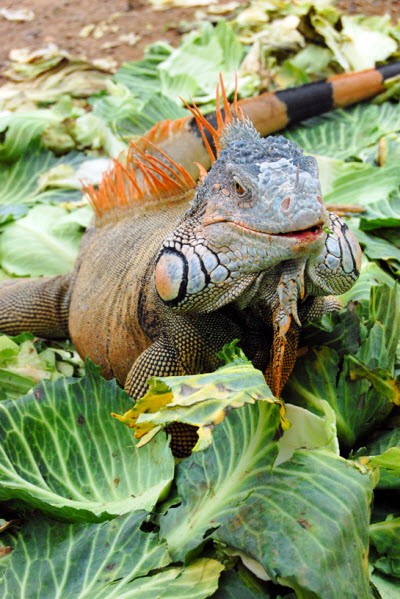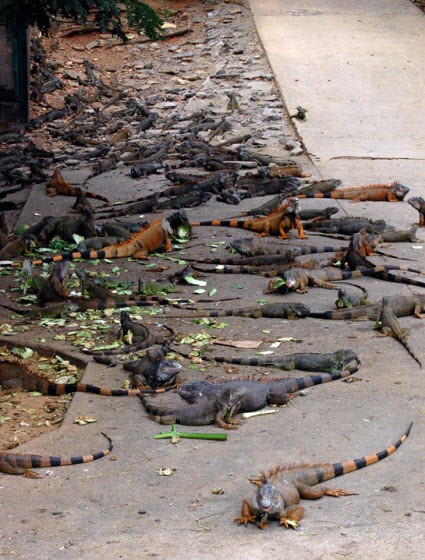The beauty of travel is that it encourages us to do things that we never thought possible. Bungee jumping in New Zealand? Okay. Eating fried spiders in Cambodia? Sure. Swimming with great white sharks in South Africa? Of course.
 What is it about hitting the road that makes us throw inhibition to the wind? Perhaps it is the knowledge that if we don’t seize this opportunity now, we never will. Or perhaps it is the sense of abandon that often accompanies travel.
What is it about hitting the road that makes us throw inhibition to the wind? Perhaps it is the knowledge that if we don’t seize this opportunity now, we never will. Or perhaps it is the sense of abandon that often accompanies travel.
It was in that spirit of adventure that I allowed myself to be talked into visiting an iguana farm. Now, let me preface this by saying I am petrified of lizards. Any size, shape, nationality, it scares me. At the very top of my list are blue tongue lizards. The sight of a blue tongue in summer, stalking around my backyard, fills me with dread.
I thought blue tongues would remain the primary source of my fear until I moved to the Cayman Islands, home to more iguanas than you could possibly imagine. So, the idea of going to an iguana farm was laughable, to say the least.
But my boyfriend and I were on the Honduran island of Roatan, and, I guess, travel prevailed. We arrived at Arch’s Iguana Farm by scooter (another travel-only experience) after my boyfriend insisted that it was an attraction he had to see. I could wait outside, but he wanted to go in. The farm (backyard zoo would be a more apt description) has become renowned for its bounty of iguanas and for the owner, Arch, an elderly Honduran man who runs the household of reptiles.
Iguanas are a protected species in Honduras, but local poachers have not been deterred from killing them for sport or meat. Arch started the farm in an effort to protect the species of green iguana that is native to Honduras, and the venture went from strength to strength, or iguana to iguana, if you will. It is now one of Roatan’s more offbeat tourist draw cards.
It was a noble pursuit, but I was happy to stay outside.
“Okay, I’m going in,” my boyfriend said, as he set off down the long driveway that served as the entrance to the farm. “Just stay here and I’ll be back in a bit.”
At the bottom of the driveway was a writhing pit of iguanas. They were everywhere, hundreds of them, climbing over the top of each other or basking on the sun-dappled concrete. It was the most disgusting thing I have ever seen. In the middle of it all stood a young girl, about seven years old, in a peach sundress.
“Come in,” she called to my boyfriend, who was walking towards the swarm of iguanas. I stood rigid at the top of the driveway. “Come down,” she called again, this time directed to me.
“She’s too scared,” my boyfriend said. “She’s going to stay there.”
 “It’s safe,” the girl tried again. “The iguanas are more scared of you than you are of them.” (I highly doubt that).
“It’s safe,” the girl tried again. “The iguanas are more scared of you than you are of them.” (I highly doubt that).
“How many are there?” I ventured.
“Three thousand,” she replied, with the nonchalance of a seven-year-old who has 3000 iguanas as pets. “Two thousand on the ground and a thousand in the trees.”
I felt the hairs on the back of my neck stand up and a shiver go through my spine. Yuck.
“Well, it looks like the iguanas are here, whether you stay up there or come down here,” my boyfriend said. “Might as well come down here where you can see them.”
That was it. I was going to go among the iguanas. I was in Honduras. If I was going to face my lizard fears (and I hadn’t actually ever planned on doing that), it was now or never. And there might as well be a seven-year-old to talk me through it.
I took the first few tentative steps down the driveway. Iguanas scurried from my path, into the safety of the nearby rocks. Every step felt like an effort, when all I wanted to do was run screaming in the opposite direction. There was a line of iguanas along each side of the driveway, almost like they were greeting me in procession. As I reached the bottom of the driveway, where the piles of iguana were so thick I could not see the ground, I felt something resembling repulsion and triumph.
“See, they won’t hurt you,” said the girl. She moved among the iguanas with an indifference that I found astounding and impressive.
We had missed feeding time but were free to walk around the farm, watching the iguanas as they lazed in the sun or munched their way through piles of lettuce. I kept my distance, and I’m ashamed to say I may have run when one came towards me with a menacing glint in its eye (even if I was the only one who saw it).
The farm was full of characters, from the cheerful little girl to the aging owner, who wandered past us carrying an iguana in his arms. On a plastic chair sat a middle-aged Honduran man, in a Rastafarian hat, who was quick to espouse on the benefits of iguana meat as an aphrodisiac. I’m not sure who he was, but he was full of iguana-related tales, including a claim that he once caught a 12-foot boa constrictor while it was eating an iguana.
It seems the iguana farm was more a refuge, where thousands of iguanas that would otherwise have been hunted in the wild, could roam as they pleased. I still wanted no part of it, but I could appreciate the somewhat distorted attempt at conservation.
As we went to leave, I passed the parade of iguanas with a little more poise. My lizard phobia was in no way gone, but I had passed from a state of terrified into merely scared. Isn’t that the point of travel? To open your mind to the experience and embrace the thrill, the discomfort, the utter joy of the unknown. I hadn’t exactly embraced the iguanas, but I had tried.
India Lloyd is an Australian journalist living in the Cayman Islands.







Crikey is committed to hosting lively discussions. Help us keep the conversation useful, interesting and welcoming. We aim to publish comments quickly in the interest of promoting robust conversation, but we’re a small team and we deploy filters to protect against legal risk. Occasionally your comment may be held up while we review, but we’re working as fast as we can to keep the conversation rolling.
The Crikey comment section is members-only content. Please subscribe to leave a comment.
The Crikey comment section is members-only content. Please login to leave a comment.